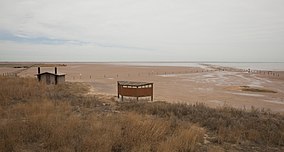Great Salt Plains National Wildlife Refuge
| Salt Plains National Wildlife Refuge | |
|---|---|
|
IUCN category IV (habitat/species management area)
|
|

Crystal digging area of the Salt Plains
|
|
| Location | Alfalfa County, Oklahoma |
| Nearest city | Jet |
| Coordinates | 36°45′01″N 98°13′27″W / 36.750314°N 98.224259°WCoordinates: 36°45′01″N 98°13′27″W / 36.750314°N 98.224259°W |
| Area | 32,080 acres (129.8 km2) |
| Established | 1930 |
| Governing body | United States Fish and Wildlife Service |
| Website | Salt Plains National Wildlife Refuge |
| Designated | June 1983 |
The Salt Plains National Wildlife Refuge is part of the United States system of National Wildlife Refuges. It is located in Alfalfa County in northern Oklahoma, north of Jet (pop. 230), along Great Salt Plains Lake, which is formed by a dam on the Salt Fork of the Arkansas River.
The refuge was established March 26, 1930 by executive order of President Herbert Hoover and contains 32,080 acres (130 km2) of protected land as habitat to approximately 312 species of birds and 30 species of mammals. It was designated a National Natural Landmark in June 1983.
The Salt Plains were a favorite hunting ground for American Indians. Bison and other game came to the area to eat the salt and the heavily wooded and well-watered area along the Salt Fork River was like an oasis in the surrounding grassland of the Great Plains. Salt Plains refuge is divided into almost equal areas of non-vegetated salt flat, open water, and vegetated land. Marshes, woods, grassland, and cropland dot the refuge. Management tools used to enhance the habitat for wildlife include farming, grazing, prescribed burns, construction of ponds, and wetland draining and flooding.
The refuge was created to be a resting and breeding ground for migratory waterfowl especially during fall and spring. The entire refuge is designated as critical habitat for the endangered whooping crane, which is mostly seen during fall migration. In addition, the refuge is home to endangered least terns, threatened snowy plovers, threatened bald eagles and peregrine falcons. Large populations of American white pelicans migrate through between August and September, staying on the Great Salt Plains Reservoir. Great Salt Plains is one of the most important habitats for shorebirds in the Western Hemisphere.
...
Wikipedia

